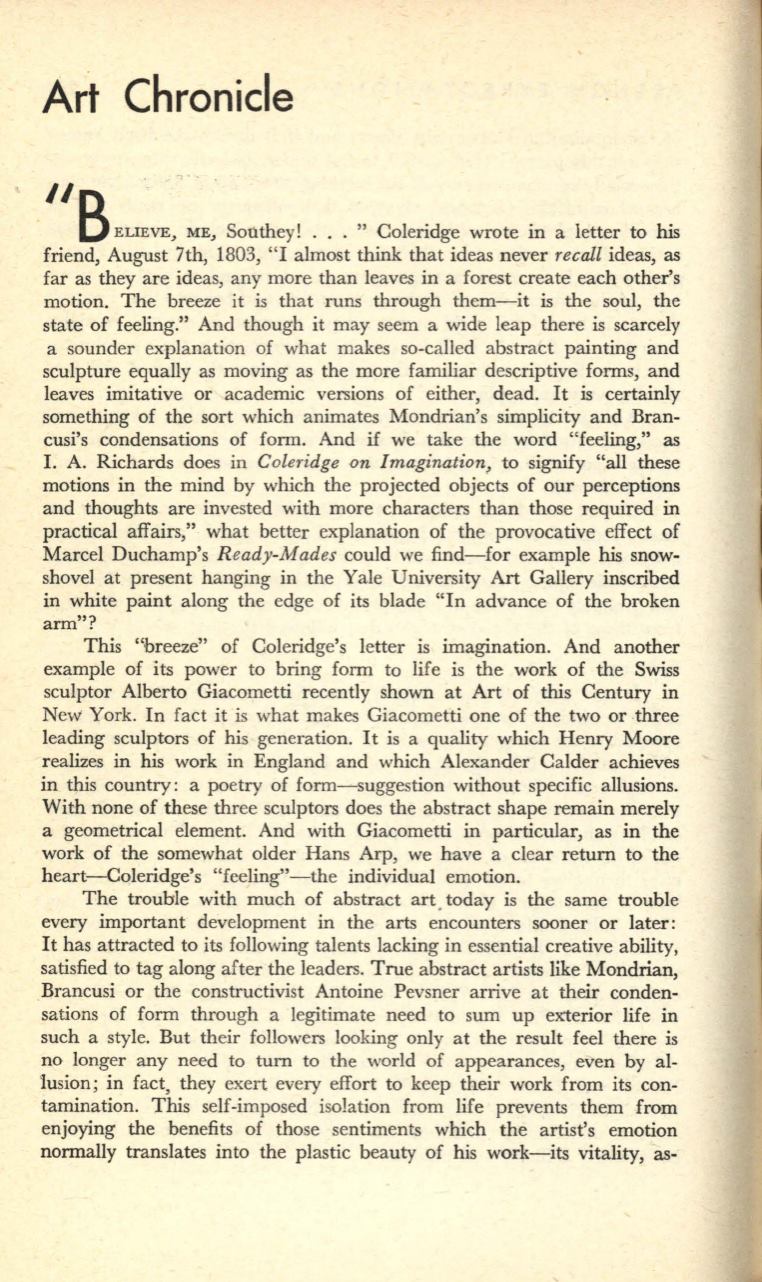
Art
Chronicle
1/
B
ELmvE, ME,
SoUthey! ... " Colcridge wrote in
a
lettcr to h;,
friend, August 7th, 1803, "I almost think that ideas never
recall
ideas, as
far as they are ideas, any more than leaves in a forest create each other's
motion. The breeze it is that runs through them-it is the soul, the
state of feeling." And though it may seem a wide leap there is scarcely
a sounder explanation of what makes so-called abstract painting and
sculpture equally as moving as the more familiar descriptive forms, and
leaves imitative or academic versions of either, dead. It is certainly
something of the sort which animates Mondrian's simplicity and Bran–
cusi's condensations of form. And if we take the word "feeling," as
I.
A. Richards does in
Coleridge on Imagination,
to signify "all these
motions in the mind by which the projected objects of our perceptions
and thoughts are invested with more characters than those required
in
practical affairs," what better explanation of the provocative effect of
Marcel Duchamp's
Ready-Mades
could we find-for example
his
snow–
shovel at present hanging in the Yale University Art Gallery inscribed
in white paint along the edge of its blade "In advance of the broken
arm"?
This "breeze" of Coleridge's letter is imagination. And another
example of its power to bring form to life is the work of the Swiss
sculptor Alberto Giacometti recently shown at Art of this Century in
New
York. In fact it is what makes Giacometti one of the two or .three
leading sculptors of his generation.
It
is a quality which Henry Moore
realizes in his work in England and which Alexander Calder achieves
in this country: a poetry of form-suggestion without specific allusions.
With none of these three sculptors does the abstract shape remain merely
a geometrical element. And with Giacometti in particular, as in the
work of the somewhat older Hans Arp, we have a clear return to the
heart-Coleridge's "feeling"-the individual emotion.
The trouble with much of abstract art. today is the same trouble
every important development in the arts encounters sooner or later:
It has attracted to its following talents lacking in essential creative ability,
satisfied to tag along after the leaders. True abstract artists like Mondrian,
Brancusi or the constructivist Antoine Pevsner arrive at their conden–
sations of form through a legitimate need to sum up exterior life in
such a style. But their followers looking only at the result feel there is
no longer any need to turn to the world of appearances, even by al-
1usion; in fact, they exert every effort to keep their work from its con–
tamination. This self-imposed isolation from life prevents them from
enjoying the benefits of those sentiments which the artist's emotion
normally translates into the plastic beauty of his work-its vitality, as-


